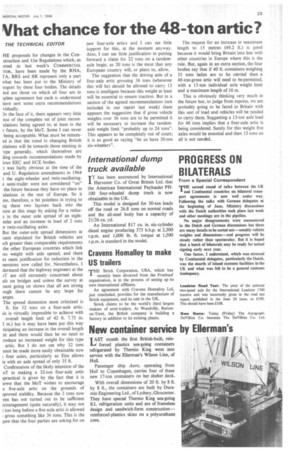Vhat chance for the 48-ton artic?
Page 31

If you've noticed an error in this article please click here to report it so we can fix it.
THE TECHNICAL EDITOR
HE proposals for changes in the Construction and Use Regulations which, as arted in last week's COMMERCIAL TOR, have been made by the RHA, f A, BRS and BR represent only a part what has been put to the Ministry of nsport by these four bodies. The details ted are those on which all four are in tplete agreement but each is understood have sent some extra recommendations vidually.
)n the face of it, there appears very little nce of the complete set of joint recomIdations being agreed to, at least in the r future, by the MoT. Some 1 can never being acceptable. What must be rememed is that the trend in changing British ulations will be towards those existing in .ope generally, which themselves are ding towards recommendations made by ious EEC and ECE bodies.
It was fairly obvious at the time of the and U. Regulation amendments in 1964 t the eight-wheeler and twin-oscillatinga semi-trailer were not considered -on" the future because they have no place in ulations in the rest of Europe. So it ms, therefore, a bit pointless in trying to rig these two layouts back into the ture at this stage by asking for a reduc3 in the outer axle spread of an eighteeler and an increase in load of 2 tons :r twin-oscillating axles.
But the outer-axle spread dimensions at :sent stipulated for British vehicles are ich greater than comparable requirements the other European countries which link rss weight with axle spread, and there es seem justification for reduction in the nensions now called for. Nevertheless, I derstand that the highway engineers at the 3.1. are still extremely concerned about tds on bridges and unless the survey at :sent going on shows that all are strong Dugh there cannot be any hope for anges.
The spread dimension most criticized is ft. for 32 tons on a four-axle artic. is is virtually impossible to achieve with overall length limit of 42 ft. 7.75 in. 3 m.) but it may have been put this way ticipating an increase in the overall length tit and there would then be no need to Toduce an increased weight for this type artic. But I do not see why 32 tons nnot be made more easily obtainable now I four axles, particularly as Eire allows is with an axle spread of only 35 ft.
Confirmation of the likely intention of the oT in making a 32-ton four-axle artic 'practical is given by the fact that it is 'own that the MoT wishes to encourage e five-axle artic on the grounds of 'proved stability. Because the 2 tons now yen has not turned out to be sufficient icouragement (quite naturally), it may not : too long before a five-axle artic is allowed gross something like 36 tons. This is the pre that the four parties are asking for on
new four-axle artics and I can see little upport for this, at the moment anyway. Also, I can see little justification in putting forward a claim for 22 tons on a tandemaxle bogie, as 20 tons is the most that any European country will, or plans to, allow.
The suggestion that the driving axle of a four-axle artic grossing 36 tons (whenever this will be) should be allowed to carry 13 tons is intelligent because this weight at least will be essential to ensure traction. But in a section of the agreed recommendations (not included in our report last week) there appears the suggestion that if gross vehicle weights over 36 tons are to be permitted it will be necessary to increase the tandemaxle weight limit "probably up to 24 tons". This appears to be completely out of court; it is as good as saying "let us have 30-ton six-wheelers". The request for an increase in maximum length to 15 metres (49.2 ft.) is good because it would bring Britain into line with other countries in Europe where this is the rule. But, again in an extra section, the four bodies say that if 40 ft. containers weighing 35 tons laden are to be carried then a 48-ton-gross artic will need to be permitted, with a 13-ton individual axle weight limit and a maximum length of 16 m.
This is obviously thinking very much in the future but, to judge from reports, we are probably going to be faced in Britain with this sort of load and vehicles will be needed to carry them. Suggesting a 13-ton axle load for 48 tons implies that a four-axle artic is being considered. Surely for this weight five axles would be essential and then 13 tons on all is not needtd.




























































































































